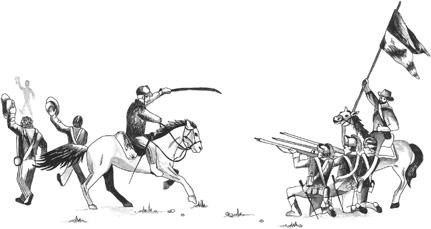
THE Grand old Duke of York,
He had ten thousand men.
He marched them up to the top of the hill
And he marched them down again.
And when they were up, they were up;
And when they were down, they were down.
And when they were only halfway up,
They were neither up nor down.
The Duke of York has historically been the title of the reigning monarch’s second son, the Prince of Wales being that of the firstborn, and so the Grand Old Duke of York could have been any of them down the years. But investigation into English military history narrows down the search to just one candidate – Prince Frederick (1763-1827), son of ‘mad’ King George III and whose elder brother is the subject of another well-known rhyme (see Georgie Porgie). Indeed, both brothers have starred in more than their fair share of rhymes.
One theory, popular in Yorkshire, relates to the purchase of Allerton Castle, a grade one listed Gothic mansion close to Harrogate, by Prince Frederick in 1786. This Duke of York had much of the place rebuilt before selling it soon afterwards in 1789. Part of his programme of renovation was the construction of what he called his Temple of Victory – named after the Roman temple on the Palatine Hill in Rome – on the top of a 200-foot hill clearly visible for miles around. To this day, travellers can see the Temple as they drive along the A1 between Harrogate and York. Local legend has it that the worker-ant-like activity of the duke’s men carrying materials up and down the hill inspired the famous rhyme.

A more convincing argument pinpointing Prince Frederick’s claim to be the Grand Old Duke has been traced to the French Revolutionary Wars (1792-1802). In 1793, he was appointed field marshal and given a simple brief –invade France! Never a great military leader, however, Frederick failed to win the trust and confidence of his men and, despite a small victory over French forces at Beaumont in April 1794, he was trounced at Tourcoing in May and consequently relieved of his position. The hill he is supposed to have marched his men up and down before having them accidentally slaughtered is thought to be Mont Cassell, in northern France, standing nearly 600 feet above the Flanders coastal plain.
But that wasn’t the end of the military career of the Grand Old Duke of York, as he was back in action five years later, in 1799, this time having been appointed commander-in-chief of the British forces by his less than sane father. In 1799, he was sent to join allied Russian forces to invade Holland. However, soon after the Duke of York arrived upon the scene, both discipline and morale among his men crumbled. The duke’s lack of military experience as a field commander was apparent and, after he signed the Convention of Alkmaar on 10 October that year, a humiliating withdrawal was ordered.
Some researchers believe that ‘The Grand Old Duke of York’ was written to mock Frederick’s hapless campaigns, in which many a hill would no doubt have been climbed, although he is now remembered in a more positive way – for his later wide-ranging reforms of the British forces that introduced the training and structural improvements that, in turn, paved the way for the military successes of Admiral Nelson and the Duke of Wellington. Under Frederick’s overall command, these two military heroes eventually crushed Napoleon and his imperial fleet and army at Trafalgar (1805) and Waterloo (1815) respectively.
But there is another Duke of York who also fits the profile – James II, second son of King Charles I (see Rock-a-Bye, Baby). This theory centres on the Glorious Revolution of 1688 when the king marched his army from London to Salisbury Plain to confront William of Orange, only to discover many of his closest allies, including the Duke of Marlborough, had switched allegiance and were now lined up on the side of the Dutch invader. This surprise discovery caused King James to beat a hasty retreat (He marched them down again), or so the story goes. The nursery rhyme neatly demotes the greatly disliked, openly Catholic king back to his former title, much as his own actions did.
I wonder what future nursery rhymes might be influenced by our own present royal family. Let’s face it, the current Duke of York, Prince Andrew, might have been a bit of a lad when he was younger, but it is looking increasingly likely that the future Duke of York, Prince Harry, may eclipse all who went before. Here’s to interesting times!